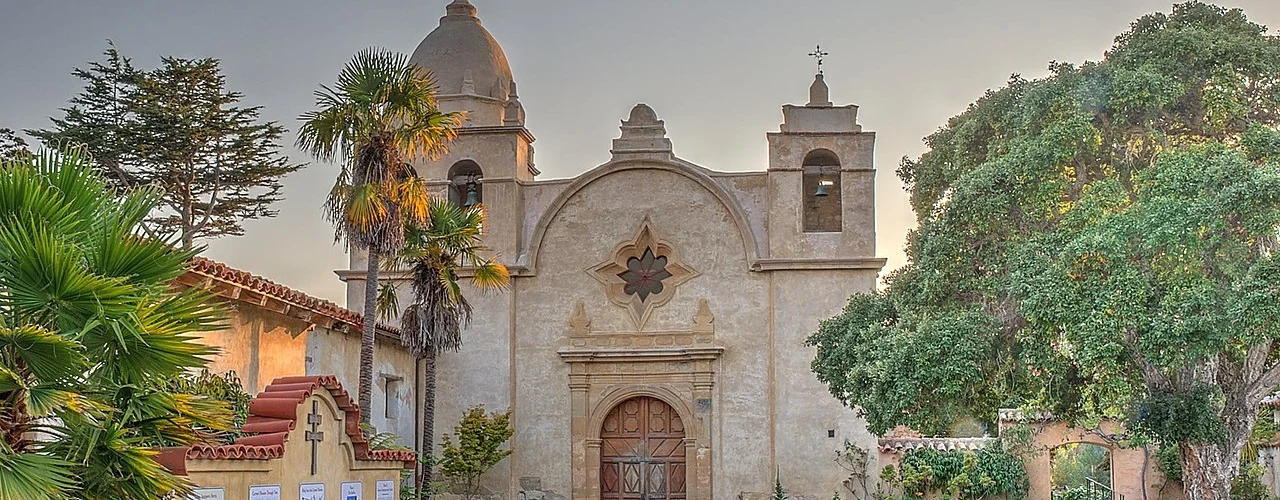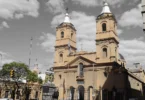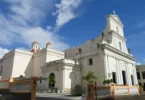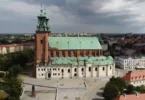Introduction
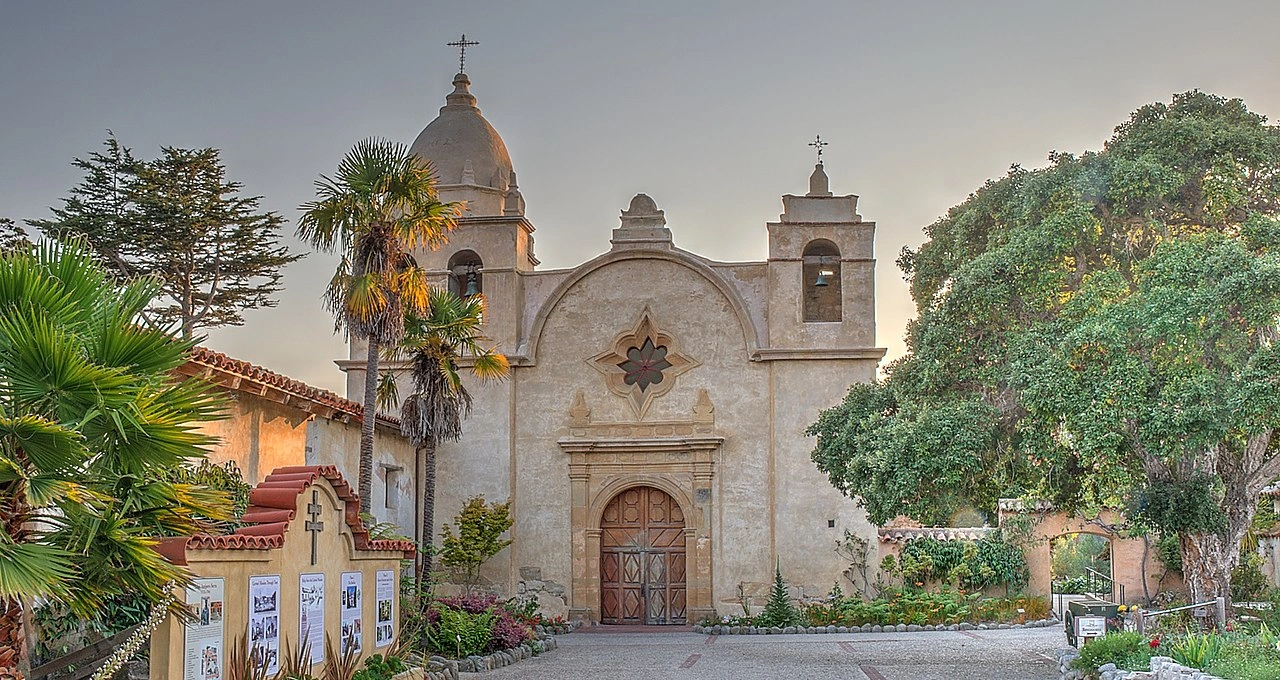
Mission San Carlos Borromeo del Río Carmelo (English: The Mission of Saint Charles Borromeo of the Carmel River), first built in 1797, is one of the most authentically restored Catholic mission churches in California. Located at the mouth of Carmel Valley, California, it is on the National Register of Historic Places and is a National Historic Landmark. From 1797 until 1833, Carmel Mission was the headquarters of all Alta California missions. It was headed by Saint Junípero Serra from 1770 until his death in 1784. It was also the seat of the second missions presidente, Father Fermín Francisco de Lasuén, who was in charge of completing nine more mission churches. In 1833 the mission buildings and lands were secularized by the Mexican government. By the mid-19th century, the Carmel Mission structures had fallen into disrepair. The chapel was saved from total destruction when the roof was rebuilt in 1884. In 1886, ownership of the mission was transferred from a group of Franciscans to the Diocese of Monterey. Ever since, Carmel Mission has been a parish within that diocese. Beginning in 1931, Harry Downie began restoring the mission and worked continuously on the project for the next 50 years. It is the only Spanish mission in California that has its original bell and bell tower. Carmel Mission contains the state’s first library.

Mission Carmel, also called The Carmel Mission) was the second mission built by Franciscan missionaries in Upper California. It was first established as Mission San Carlos Borromeo in Monterey, California near the native village of Tamo on June 3, 1770, by Father Junípero Serra. It was named for Carlo Borromeo, Archbishop of Milan, Italy, and was the site of the first Christian confirmation in Alta California.
Relocation to Carmel Valley
From 1770 to 1774, Pedro Fages was the military governor of Alta California. He kept his headquarters in the Presidio of Monterey, the city’s capital. Fages worked his men very harshly and was seen as a tyrant. Fages’ soldiers were represented by Serra, but the two men did not get along. Fages regarded the Spanish installations in California as military institutions first, and religious outposts second. The soldiers raped the Indian women and kept them as concubines.Serra wanted to put some distance between the mission’s neophytes and Fages’ soldiers. Serra discovered that the land at the Carmel Valley’s entrance, where the Carmel River, which Vizcaino dubbed “Ro del Carmelo” in 1603, empties into Carmel Bay, was better suited for farming. In May 1771, Spain’s viceroy approved Serra’s petition to relocate the mission. The mission was established in the new location on August 1, 1771; the first mass was celebrated on August 24, and Serra officially took up residence in the newly constructed buildings on December 24. The name of the relocated mission was extended to Mission San Carlos Borromeo del Río Carmelo. It was within a short distance of the Rumsen Ohlone villages of Tucutnut and Achasta. The latter village may have been established following the move of Mission San Carlos to Carmel Valley. The mission was about 10 mi (16 km) from the nearest Esselen territory, Excelen. The original building in Monterey continued to operate as the Royal Presidio’s chapel and later became the current Cathedral of San Carlos Borromeo.

Serra’s headquarters
“Mission Carmel”, as it came to be known, was Serra’s favourite and, because it was close to Monterey, the capital of Alta California, he chose it as his headquarters. He was buried beneath the chapel floor on August 28, 1784, the day he passed away. Father Fermn Lasuén replaced the adobe structure with one made of stone quarried from the Santa Lucia Mountains nearby after Serra passed away.
Indian baptisms
The Franciscans began baptizing some natives shortly after the Carmel mission was relocated to the Carmel Valley’s entrance. By the end of 1771, the population of the mission was 15 with an additional 22 baptized Indians, out of a total population of northern California of 60. Farming was not very productive and for several years the mission was dependent upon the arrival of supply ships. In a 1950 essay, historian Jame Culleton stated, “The summer of ’73 arrived without the supply ship.” Neither Carmel nor Monterey was anything like self-supporting.” They tried to convert important members of the Esselen and Rumsen tribes, including chiefs, in order to increase baptism rates. On May 9, 1775, Junípero Serra baptized what appears to be the first Esselen, Pach-hepas, the 40-year-old chief of the Excelen. He was near death and was baptized in his home village at Xasáuan, about 10 leagues (about 26 mi (42 km)) southeast of the mission, in an area now named Cachagua, a close approximation of the Esselen name.
Forced labor
The Esselen and Ohlone Indians who lived near the mission were baptized and then forcibly relocated and conscripted as forced laborers. Around 900 Esselen were baptized over the years and brought to the two missions in their native area Carmel Valley, Soledad, and San Antonio. During the mission period, there was a lot of “comingling of the Costanoan with peoples of different linguistic and cultural background.”The neophytes were taught to be farmers, shepherds, cowboys, blacksmiths, carpenters, bricklayers, furniture makers, tanners, weavers and candle makers. These tribes were destroyed by disease, starvation, overwork, and torture. 114 The missions saw a significant number of native deaths. Deaths exceeded births and the population at Mission San Carlos peaked in 1795, when the population reached a total reported variously as either 876 or 927, but by 1823 the total had dwindled to 381.
Crops and livestock
In the beginning, the mission relied on bear meat from Mission San Antonio de Padua and supplies brought by ship from Mission San Diego de Alcalá. The Native Americans at Carmel Mission harvested 1,660 bushels of wheat, 700 bushels of barley, 165 bushels of beans, and 85 bushels of maize in 1779, four years after the first baptism at Esselen. The native laborers produced enough crops four years later to support 700 people. The mission had more than 500 cattle and sheep. Carmel Mission continued to grow during most of the 18th century. By 1800, agriculture production at Carmel Mission was near its peak. The Mission reported to Mexico that it had 2,180 horses and cattle, and 4,160 smaller livestock, including sheep. The total grain harvested was about 3,700 bushels per year with a high of 7,400 in 1797. In December 1832, the mission reported to Mexico that it had 2,100 cattle, 3,300 sheep, 410 horses, and 8 mules.
Secularized and abandoned
The Mexican government was concerned that the missions remained loyal to the Catholic Church in Spain. Only eight months later, in August 1833, the government secularized all of the missions and their valuable lands. The government stipulated that half the mission lands should be awarded to the native people, but this purpose was never accomplished. The majority of the property at the mission was purchased by government officials or wealthy friends. The mission and its lands were quickly abandoned because the priests were unable to maintain the missions without the Indians’ forced labor. The Indians were forced from the mission by the new landowners. Some attempted to return to their native ways, and others found work as ranch hands or servants on farms and ranches. The mission was close to being destroyed by 1850. While the majority of the adobe structures were eroding, the stone chapel building was deteriorating. The roof collapsed in 1852.
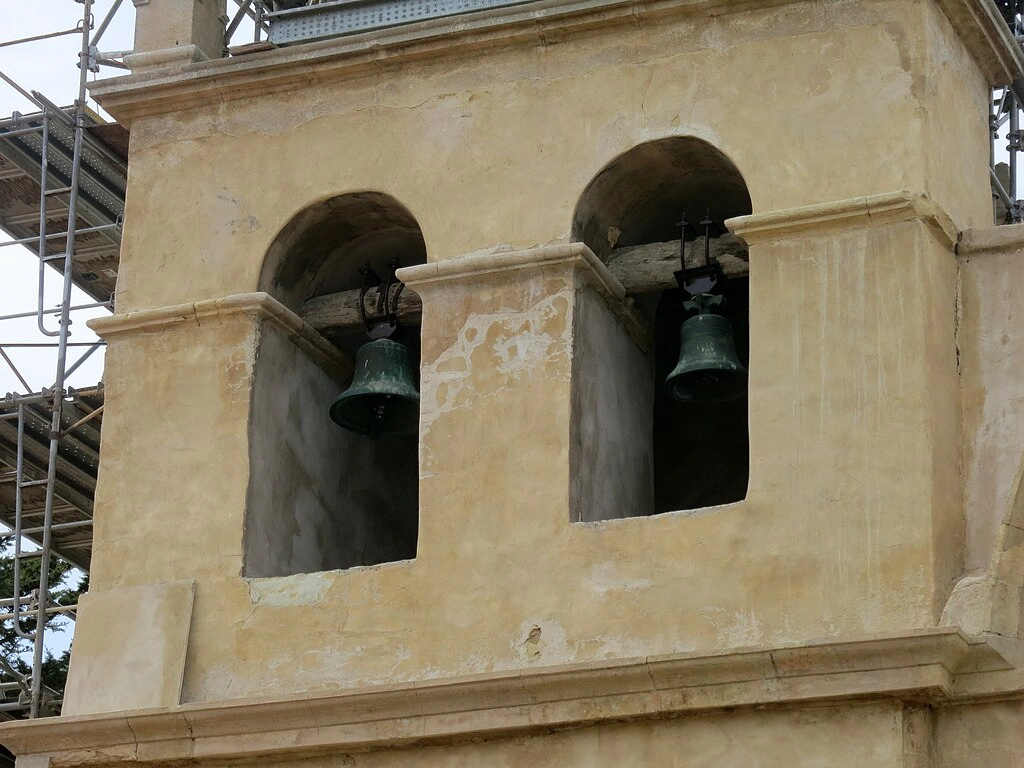
Restoration
The 1848 Treaty of Guadalupe Hidalgo stipulated that the land grants would be honored when Mexico ceded California to the United States following the Mexican–American War. However, the owners were required to provide legal proof of their title. As required by the Land Act of 1851, Archbishop Joseph Sadoc Alemany filed a claim on February 19, 1853, on behalf of the Roman Catholic Church. He sought return of all former mission lands in the State. The state agreed to give the church back the original mission gardens, cemeteries, and buildings. When the Roman Catholic Church gained full control of the buildings on October 19, 1859, the mission was in ruins. In 1884, Father Angel Casanova was successful in securing sufficient private funding to replace the chapel’s roof and preserve it until the 1930s. In 1931 Monsignor Philip Scher hired master cabinet maker Henry John (“Harry”) Downie who had an excellent reputation for restoring Spanish antiques. Scher initially asked Downie to restore some statues at the Carmel Mission but his job quickly expanded and he was put in charge of restoring the entire mission. Two years later, the church handed over the Franciscan mission to the diocese nearby, making it a regular parish church. Downie worked almost every day for nearly 50 years to restore the mission, ancillary buildings, walls, and grounds while he lived nearby in Carmel. He painstakingly researched the church’s architecture and site, often relying on original Spanish sources, and gathered genuine artifacts from across California. In 1936, he began restoring the padres’ quarters, followed by the chapel’s roof and, over the next five years, the basilica’s interior. In 1941, he oversaw restoration of the former soldiers’ quarters on the east side of the quadrangle. In 1943 he began restoration of a building that had been on the south side of the quadrangle, although nothing was left but the eroded adobe foundation and a few ruined walls. The building was originally a segregated, locked dormitory for girls called the monjero (nunnery). They were separated from their families at age 8. The boys and unmarried men also had their own dormitory, though it was less confining 117–119 .The building was reconstructed and made into classrooms for Junipero Serra Elementary School. In 1946, the ruin on the east side of the quadrangle that had been the original padre’s kitchen and a blacksmith shop was rebuilt. It is used today as a chapel. Downie also consulted on the restoration of the missions that are considered the most authentic, including San Luis Obispo, San Juan Bautista, and San Buenaventura. He also helped the Native Daughters of the Golden West to reconstruct Mission Soledad. He was knighted by Pope Pius and by King Juan Carlos of Spain. In 1960, the mission was designated as a minor basilica by Pope John XXIII. During his tour of the United States in 1987, Pope John Paul II paid the mission a visit. In 1807, Mexico City produced the first bell, which was given the nickname “Ave Maria.” It was placed at the Mission in 1820. When the mission was secularized in 1834, the bell was removed and held onto by local Native Americans for safekeeping. It was finally lost, but relocated once again, during restoration. It was re-installed in the mission bell tower in 1925.
Architecture of Carmel Mission of St. Charles Borromeo, Carmel-by-the-Sea, California, USA

Burials: Junípero Serra, Joseph Jacinto Mora, Pedro Fages.
Modern use
As a result of Downie’s dedicated efforts to restore the buildings, the Carmel mission church is one of the most authentically restored of all the mission churches in California. Mission Carmel has been designated a National Historic Landmark by the National Park Service. It is an active parish church of the Roman Catholic Diocese of Monterey. In addition to its activity as a place of worship, Mission Carmel also hosts concerts, art exhibits, lectures, and numerous other community events. Eamon MacMahon, the pastor at the time, bought a Casavant Frères organ with horizontal trumpets in 1986. The elaborate carvings and statues found on its hand-painted casework are reminiscent of the Spanish style used on the main altar. In addition, the mission serves as a museum, preserving both its own and the region’s history. The Harry Downie Museum tells the story of restoration efforts; the Munras Family Heritage Museum tells the story of one of the most important families in the area; the Jo Mora Chapel Gallery shows rotating art exhibits and Jo Mora’s monumental 1924 bronze and travertine cenotaph; and the Convento Museum shows the cell Serra lived and died in as well as interpretive exhibits. A special chapel room with some of Serra’s clothing is at one end of the museum. The Junpero Serra School, a private Catholic school for kindergarten through eighth grade managed by the Diocese of Monterey, was also housed on the mission grounds. The school closed at the conclusion of the 2019–2020 academic year after opening in 1943.

Modern restoration
Between 2000 and 2007, private funding provided funds to hire Fine Art Conservation Laboratories to conserve the major original Spanish Colonial oil paintings in the nave. The company had previously been responsible for the preservation and restoration of Spanish colonial art from the Mission Inn, Riverside, California, the Santa Barbara Mission, The Institute of Iberian Art in Santa Fe, New Mexico, and from the Permanent Art Collection of Brigham Young University. The most important artwork conserved during their initial work was the Deposition, a painting commissioned by Father Serra prior to his death. It is now hanging in the Carmel Mission apse near his tomb. Independent of the Diocese of Monterey, the Friends of Historic Carmel Mission was established in 2008. The mission of the organization was to lend a hand to the parish and diocese in their efforts to restore and protect the historic landmark. The Carmel Mission Foundation was established as the sole source of funding for the restoration of nine mission bells and numerous artifacts. In 2012, the foundation began a $6.2 million capital project to restore the Basilica which had not been touched since 1937 and had been deemed unsafe by the California State Unreinforced Masonry Act. The project was the third major reconstruction of the Basilica since it was built in 1797. The contractors installed additional wood and steel beams to reinforce and tie the roof structure together. To strengthen the walls, they drilled over 300 center-cored vertical and horizontal holes in the 5 ft (1.5 m) thick walls, into which they inserted steel rods that were grouted in place.
The bell tower dome was reinforced, cleaned and resurfaced. The electrical system was updated and a fire suppression system was added as part of the project. The interior lighting was replaced, and custom-made chandeliers were added. Foundation issues were remedied and all tile was matched and restored. The project upgraded the radiant heating system and included construction of an Americans with Disabilities Act-compliant restroom. The Basilica restoration was completed in 2013. Over the next few years, the foundation funded restoration of many artifacts in the museum and to preserve historic structures from further decay. This included the Muchado House built in 1883. The restoration of the central courtyard, which cost $2.2 million in 2016, was supported by the Foundation in 2016. The unsafe, cracked concrete surface was removed and new water and fire lines, drains, sewer, electrical, and communications lines were installed before a more durable concrete surface was poured to match that of the original aggregate poured in the late 1960s. The fountain in the courtyard was fixed up. The large Santa Maria style barbecue pits that have been used for community barbecues since 1913 were reinforced and upgraded. The gardens were replanted with native plants and outdoor lighting and electrical was installed. The foundation also created the Serra Memorial Circle in the Courtyard to honor donors. The foundation worked with the Mission Docent Association to conserve the Our Lady of Bethlehem statue, believed to be one of the oldest statues in California. In 2020, the front perimeter wall deteriorated. The foundation paid for emergency removal of the 30 feet (9.1 m) long perimeter wall and construction of a temporary wall until a permanent one can be designed and built. In late 2020, The Carmel Mission Foundation began a $4 million project to restore and seismically strengthen the century old Downie Museum in time to commemorate the 250th anniversary of the founding of Carmel Mission. The restoration doubled the museum’s interior space by removing restrooms from the building’s rear. The paint that had been covering the 1920-installed stone around the fireplace was removed. The foundation is seeking additional funding to pay for seismic retrofits, infrastructure improvements, and restoration of the Mora Museum, Convento Museum, Blessed Sacrament Chapel, and the historic Orchard House Property.
Folklore
The Lost Padre Mines of the Carmel Mission have woven themselves into the tapestry of local folklore, with their legacy recounted through various accounts, including those within Randall Reinstadt’s notable works such as Ghosts, Bandits, and Legends of Old Monterey, Carmel and Surrounding Areas and Tales and Treasures of California Missions. These narratives unveil a captivating history, suggesting that indigenous communities held knowledge of abundant gold deposits concealed within the untamed terrain of the Santa Lucia Mountains. As whispers of these riches echoed through time, the enigmatic Lost Padre Mines became a testament to the allure of hidden treasures and the enduring mystique of the land. Numerous iterations of these legends appear to have originated from long-time residents of Carmel Valley. It is plausible that this phenomenon can be attributed to some of the final descendants of the Mission Indians who resided and labored in the area.
Vandalism
On September 27, 2015, in response to Serra’s canonization, the San Carlos Borromeo de Carmelo Mission was vandalized. The statue of Serra was toppled and splattered with paint, and the cemetery, the mission doors, a fountain, and a crucifix were as well. The message “Saint of Genocide” was painted on the ground, and similar messages were painted elsewhere in the mission courtyard.
Feast Day
Feast Day : 4 November
The main feast day of the Carmel Mission of St. Charles Borromeo in Carmel-by-the-Sea, USA, is celebrated on November 4th, which is the Feast of Saint Charles Borromeo. This day holds special meaning for the mission and its parish community.
Church Mass Timing
Wednesday to Friday : 12:00 PM
Saturday : 5:30 PM
Sunday : 9:00 AM , 11:00 AM
Church Opening Time:
Monday, Tuesday : Closed
Wednesday, Thursday : 10:00 AM, 3:45 PM
Friday, Saturday : 10:00 AM, 4:45 PM
Sunday : 11:30 AM, 4:45 PM
Contact Info
Address : Carmel Mission Basilica
3080 Rio Rd, Carmel-By-The-Sea, CA 93921, United States.
Phone : +1 831-624-1271
Accommodations
Connectivities
Airway
Carmel Mission of St. Charles Borromeo, Carmel-by-the-Sea, California, USA, to Monterey Regional Airport, distance between 10 min (7.7 mi) via CA-1 N.
Railway
Carmel Mission of St. Charles Borromeo, Carmel-by-the-Sea, California, USA, to Amtrak station, distance between 15 min (7.6 mi) via CA-1 N and CA-68 E.

